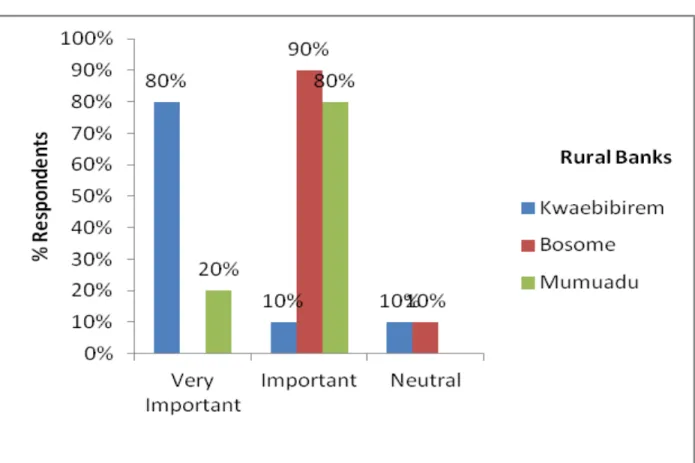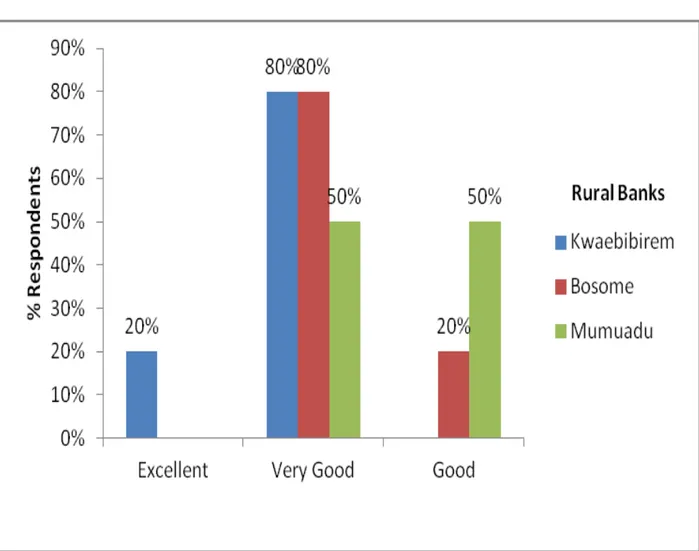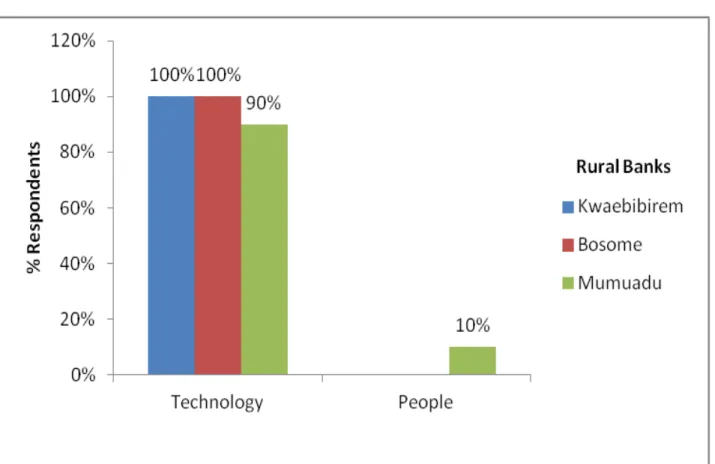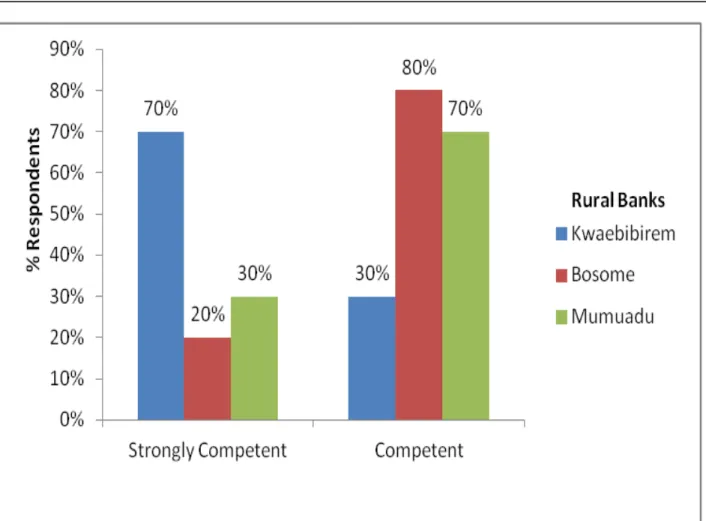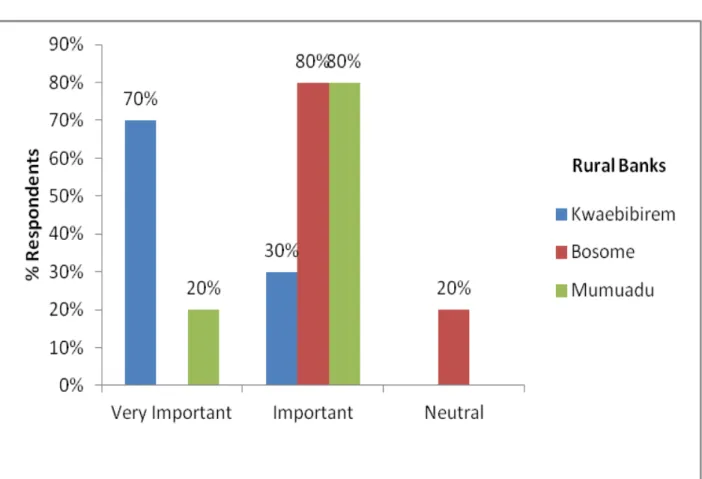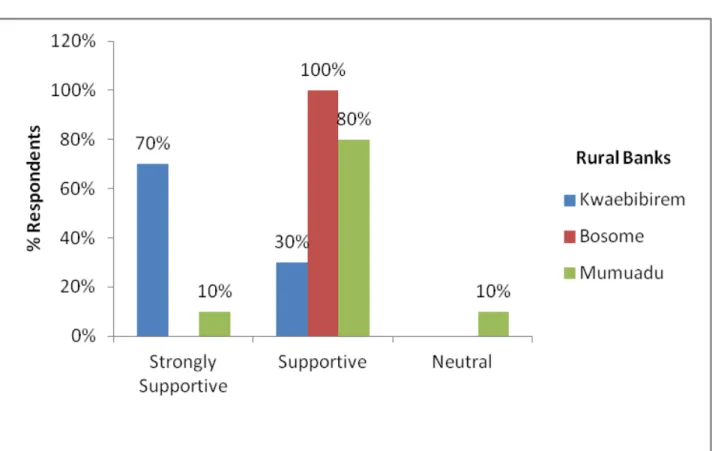159
The Effect of Corporate Governance on Strategic Change
in Financial Institutions: Evidence from Ghana
Samuel Antwi
Koforidua Polytechnic, P.O.BoxKf 981, Koforidua, Ghana, School of Finance and Economics, Jiangsu University, China
Email-samyantwi@yahoo.com
Frederick Binfor
Marketing Department, Oil Palm Research Institute, Kade, Ghana Email-kobbyfred@yahoo.co.uk
Abstract
The research has investigated the effect of corporate governance on strategic change in rural banks in the Eastern Region of Ghana. It was also examined the importance of governance mechanism and strategic decisions on weaknesses and threats to the banks effective operation. It has examined the understanding of ownership, board, and the top management team in strategic change on banks values. It has also revealed the relationship between strategic/policy changes and the bank performance in the community. A quantitative methodology was used for the study. The main instrument used for data collection was self-developed questionnaire. It was revealed that the importance of governance mechanism and strategic decisions on weaknesses and threats to the effective operation of the banks were 80% very important and 90% important. However, 70% of the management personnel strongly support formal policy development and implementation of the bank. The research concluded that corporate governance has an effect on strategic change on rural banking. It is recommended that strategic changes in rural banks can be implemented if the top management team and Board of Directors agreed and placed high importance on it. A good implementation of strategic change in rural banks will really improve their performance.
Keywords: Corporate Governance, Strategic Change, Financial Institutions, Ghana
1.0Introduction
Over the last 15 years corporate governance has become one of the most topical issues in business and finance discourses (Keasey et al. 2005). Corporate governance is associated with
the defe se of sha eholde s’ i te est the use of fi go e a e de i es Joh so a d
160
Corporate governance is the system by which business corporations are directed and controlled. The structure of corporate governance specifies the corporation between the board, managers, shareholders and other stakeholders. The structure again, spells out the rules and procedures for making decisions on corporate affairs. By doing this, it also provides the structure through which the organization objectives are set. The structures give the means of attaining those objectives and monitoring performance. Organizations are there typically to serve the interest of widely dispersed stakeholders (that is, investors, customers, government, community members, employees, suppliers, citizens). But day-to-day control is entrusted to a small group of managers who may have little direct interaction with stakeholders. The question is: How then to ensure that managers serve the interest of stakeholders, rather than their own private interest? The need for an organization to have corporate governance arrangements are an important part of the answer. These arrangements encompass the power given to
management, control o e a age e t’s use of po e via institutions such as board of
di e to s , a age e t’s a ou ta ilit to stakeholde s a d the fo al a d i fo al p o esses
by which stakeholders influence management decisions. In the private and quasi-private sectors, the traditional governance model positions management as accountable solely to investors (shareholders). But a growing number of corporations accept that stakeholders other than shareholders are affected by corporate activity, and that the corporation must therefore be answerable to them. This idea is the foundation of corporate social responsibility, and provides the link between CSR and governance. A board of directors often plays a key role in
corporate gove a e. It is thei espo si ilit to e do se the o ga izatio ’s st ateg , de elop
directional policy, appoint, supervise and remunerate senior executives and to ensure accountability of the organization to its owners and authorities. In Ghana, many of research on the corporate governance attempted to focus on the operation of corporate board but little has been done in the area of governance and strategic change, most commonly the board, while excluding others like ownership and top management. Especially, the notion of corporate
go e a e as deali g ith the i te a tio et ee a fi ’s o e ship, oa d a d top
management has not been sufficiently explored in the literature. The track record of success in bringing about strategic change within organizations is poor. For strategic intent to become reality, it is necessary to change the way in which individuals within an organization behave. These often involve radical transitions within an organization that encompass strategy, structures, systems, processes and culture. Change is about changing people, not organizations. Organizations change when the managers and employees change their way of doing business. This is what board of directors is set up to look into. In this research, the aim will be on the step towards overcoming some of these shortcomings by examining how different governance structures operate and interact to promote o ga izatio ’s ability to change strategically.
2.0 Literature Review
161
inhibit changes, and factors contributing to flexibility are considered strengths that support the need for change. Governance strategic change in organization should be responsibilities of ownership, board, and the top management team. Corporate governance mechanism should ensure that, the strategic change brings corporate fairness, transparency and accountability. For Banking Institutions to ensure transparency, their annual reports should disclose true and fair accounting information prepared in accordance with applicable standards. The corporate governance must promote active cooperation between ownership, Board, and the top management team in order to change the operations strategically. Organization gives a little recognition to corporate governance mechanism as a major contributor to organizations performance. Organization should know that, strategic change in businesses promote wealth
eatio . The uestio is is the o e ship, oa d, a d top a age e t tea ready to change
st ategi all ? In the wake of the worldwide trend to privatize and liberalize state economic enterprises, corporate governance mechanism has come to the forefront of discussions of institutional reform. Considerable attention has been given to the role of boards in monitoring
managers and in removing non-pe fo i g CEO’s a d a age s. Je se 3 oi es his
concern that a lack of independent leadership makes it difficult for Boards to respond to failure in top management team. Fama and Jensen (1983) also argue that concentration of strategic
de isio a age e t a d de isio o t ol i o e i di idual edu es Boa d’s effe ti e ess i
monitoring top management. Corporate governance generally refers to the set of mechanisms that influence decisions made by managers when there is a separation of ownership and control.
2.1 The Ownership
Since the 1970s a growing literature has developed linking corporate policies and performance with governance and ownership structures. While freely studied within academic circles, these models did not gain a more widespread popularity until very recently. Corporate scandals around the world in recent years contributed to raising awareness among managers, investors and regulators, and an effort is under way in many countries to produce quantitative measures on ownership and governance, and to estimate their impact on the value and decision-making process of firms. A great deal of attention has been given to understanding how corporate governance and ownership structures affect firm performance. Corporate governance can
i flue e a fi ’s pe fo a e he e e a o fli t of i te est a ises et ee a age e t a d
shareholders. The concentration of ownership and the unification of ownership and management lead to managers being subjected to less pressure from outside investors and other monitors who demand accountability, transparency and strategic renewal. Ownership concentration among the top management of the firm can lead to risk aversion and lack of willingness to engage in strategic change activities such as corporate diversification, product innovation or entering new international markets (George et al., 2005; Hill and Snell, 1988; Hoskisson et al., 2000). Agency theory stresses that the extent of involvement in risky activities is likely to be influenced by the ownership and governance of the firm (Fama, 1980; Fama and Jensen, 1983; Jensen and Meekling, 1976). According to this theory, equity ownership influence
162
Strategic change typically involves taking risk.
2.2 The Board Composition
A corporation, whether for-profit or nonprofit, it is required to have a governing Board of Directors. A corporation can operate as a separate legal entity, much like a person in that it can own bank accounts and can enter into contracts. However, the laws governing corporations require that a corporation ultimately is accountable to its owners. That accountability is accomplished by requiring that each corporation has a Board of Directors that represents the stockholders or the public. Members of a governing Board have certain legally required duties, including duties of care, loyalty and obedience. Board operations is often refers to the activities conducted between Board members and the phrase governance is also often refers to the
Boa d’s a ti ities to o e see the purpose, plans and policies of the overall organization. Boards of directors provide the formal link between owners and the managers responsible for the
day-to-day operations of the firm. The Boa d has ee des i ed as the ape of the fi ’s de isio
control s ste Fa a a d Je se , 3). Most rural banks, however, are owner-managed and
owners thus have direct and detailed insights into internal processes of the firm. As a result, there is less need for the control function of the Board and many rural banks Boards exist on paper only. However, there are also examples of rural banks having active Boards with outside members, using the Boards of Directors as a means for strategy development. Outside members are more likely to view the tasks of the board as being distinctly different and complementary to that of management, which insiders may view board work as an extension of their managerial responsibilities. Outside board members are not tied to the day-to-day operations of the firm and consequently they are likely to think more freely concerning the strategic alternatives open to the firm. Their experiences from contexts other than the firm also help generate new perspectives and ideas and can increase cognitive diversity.
2.3 The Top Management
Corporate governance refers to the relationship among the Board of Directors, top management, and shareholders in determining the direction and performance of the corporation (Wheelen & Hunger, 2007). The role of the Board of Directors varies a lot from a country to another, from industry to another and from company to another. Many scholars
o side that the p i a espo si ilit of the Boa d of Di e to s is to p ote t the sha eholde s’
assets and ensure they receive a decent return on their investment (Kennon, 2008). In contrast to that in some European countries, the sentiment is much different. This is because; many directors there feel that it is their primary responsibility to protect the employees of a company first, the shareholders second. In these social and political climates, corporate profitability takes
a back seat the needs of workers (Kennon, 2008). Age theo suggests that top a age s’
inclination to change strategy is linked to the ownership structure of the firm (Bethel and
Liebeskind, 1993 . This is e ause a age s’ ealth i eases ith g o th a d di e sifi atio ,
163
cognitive characteristics, such as values, norms and interests, significantly influence the way that firms process and interpret information about their markets and customers, thus impacting also their ability to recognize and pursue strategic change. The effect of top management team characteristics on strategic change is likely to be particularly strong in rural banking because small size and flexible organizational structures intensify top management
tea ’s involvement in all activities of the firm.
2.4 The interaction effect of ownership and outside directors on strategic change
There is a potentially important link between ownership structure, Board of Directors and strategic change. Fiegener (2005) found that the Board is less likely to participate in strategic decisions in where ownership and management are separated if the CEO is the majority owner.
The reason is that, the owner-manager has power to influence strategic decisions and change in other ways that forestall the participation of the Board. Interestingly, Fiegener (2005) does not find support for the suggestion that Boa ds’ st ategi pa ti ipatio is less likel he the e is a larger group of family members of the CEO holding majority ownership. This suggests that a board with outside board members is likely to be more involved in strategic change in closely held firms with many active members of the owner-family compared to firms where there is only one owner who is also CEO. It can further be argued that in firms that are not closely held, where ownership and management are separated, one important role for Board is to safeguard
sha eholde s’ i est e ts i the fa e of pote tial a age ial oppo tu ism, putting emphasis on monitoring and control. Outside directors are not familiar with the day-to-day operations of firms but instead dependent on information passed on to them by management. Opportunistic management can choose which information to disclose and which to contain, and whether to present accurate or biased information. As a result, outside directors tend to rely more on financial evaluations than on strategic evaluations because such information is less ambiguous and unlikely to be biased. Consequently, strategic governance is likely to be low and managers are evaluated more on financial outcomes. In closely held firms the role of the board is different, because the risk of opportunistic behavior by management is lower (or zero).
2.5 The presence of outside directors has a stronger positive effect on strategic change among closely held firms.
164
and opportunities for strategic change. However, if there are no outside directors on the Board, it may develop a myopic and narrow view of the firm, stalling strategic change. In such cases, the ability of the top management team to internally generate different viewpoints and options
for change becomes increasing important. Mo eo e , o e of the oa d’s ke oles is to o ito
and control top management, which includes giving voice in strategic decisions. The Board is more likely to be active and play this role with outside members. In this situation, the Board may constrain and limit the room for strategic change initiatives of the top management team.
2.6 Risk Recognition and Assessment
An effective internal control system requires that the material risks that could adversely affect
the a hie e e t of the a k’s goal a e ei g e og ized a d o ti uall assessed. This assessment should cover all risks facing the bank and the consolidated banking organization, that is, credit risk, transfer risk, market risk, interest rate risk, operational risk, and reputational risk. Internal controls may need to be revised to appropriately address any new or previously uncontrolled risks.
2.7 Orga izatio s’ Perfor a e
The principal objective of an organization is to enhance economic value for all shareholders by making the most efficient use of its resources. An organization that meets shareholders expectations will have greater internally generated resources. This will enable the organization to be able to pay tax, train its workforce, retain its key staff and meet its social obligations.
2.8 Disclosure and Transparency
OECD (1999) principles state that, the corporate governance framework should ensure that timely and accurate disclosure is made on all material matter regarding the company including, the financial situation, the performance, ownership and governance of the company Transparency is letting the truth be available for others. This implies a passive position on the private organizations under consideration. Nowadays, transparency has taking a whole new meaning that is active disclosure. The concept transparency requires not only letting the truth available by private organizations but imposes to disclose it to every stakeholder. Disclosure should be timely and adequate to enable investors, third party analyst, or rating agencies to assess the quality of corporate governance and the true financial condition of the organization.
3.0 Methodology
3.1 Research Design
165
diffe e e i the fo , ualit , o the state o e ti e i a o ga izatio ’s alig e t with its
external environment Va de Ve a d Poole, 5 . A o ga izatio ’s alig e t ith its
external environment is defined as the fundamental pattern of present and planned resources developments and environmental interactions that indicates how the organization will achieve its objectives (Hofer and Schendel, 1978). Corporate governance is defined as a new system by which business corporations are directed and controlled (OECD, 1999). Consistently Keasey et
al. (1997) has defined corporate governance toinclude the structures, processes, cultures and
systems that engender the successful operation of organizations. Data collected for the research were both primary and secondary. Primary data was collected by means of questionnaires and secondary data was collected through journal, magazine and companies website. Variable like company size, profit and company maturity were controlled.
3.2 Sampling Method and Data Collection
Purposive sampling technique was used for data collection. In all, three (3) Banks were purposively sampled because they represent rural banks that have been in existence for the past 10 years, and as such have available data bank through their company website and annual report.
Ten (10) top management personnel from each bank were also purposively sampled from various departments. In all, one (1) top management personnel were sampled from Supervising Manager, Accountant, Project Officer, Credit Officer, Internal Auditor, IT Manager, HR Manager and two (2) others.
3.3 Questionnaire Design
A 5-point likert scale was developed and used to assess view from respondents, on corporate governance on strategic change in various rural banks. In all, 30 questionnaires were administered to top management in various sections of the 3 banks (10 in each bank).The questionnaires were unstructured and closed-ended questions were used to overcome bias. The questionnaires were pre-tested for validation and reliability.
4.0 Empirical Results and Discussion
166
Source: Survey data, October 2011
Figure 1: Gender relationship between the three rural banks
167
Source: Survey data, October 2011
Figure 2 Strategic decisions towards weaknesses and threats to effective operation.
None of the respondents in Akim Bosome Rural Bank saw the strategic decision to effective operation of the bank as very important. However, 90% of the respondent accepted that
st ategi de isio s e e i po ta t a d % e e eut al to the effe ti e ess i the a k’s
168
Source: Survey data, October 2011
Figure 3 Responses of Management understanding to Ba k’s value o strategic change
K ae i i e , Aki Boso e a d Mu uadu Ru al Ba ks st o gl u de stood the a k’s alue
on strategic change in the order 30%, 60% and 20% respectively. 50%, 40% and 80% of the respondents in the Kwaebibirem, Akim Bosome and Mumuadu Rural Banks understood the
169
Source: Survey data, October 2011
Figure 4 Board of Directors understanding of a k’s value o strategi ha ge
Respo de ts f o K ae i i e Ru al Ba k sho ed that % e e eut al to the a k’s alue
170
Source: Survey data, October 2011
Figure 5 Banks image after strategic/policy changes
“t ategi /poli ha ges had a positi e i pa t o the Ba k’s i age. Respo de ts of Mu uadu
Rural Bank ranked image as good (50%), and very good (50%). However, Akim Bosome Rural
171
Source: Survey data, October 2011
Figure 6 Strategic initiatives on Banks performance
172
Source: Survey data, October 2011
Figure 7 Bank’s competence in conducting SWOT analysis in strategic change
173
Source: Survey data, October 2011
Figure 8 Rural Banks response to SWOT analysis process in strategic change.
174
Source: Survey data, October 2011
Figure 9 Relevance of Banks Policies to Current Activities
175
Source: Survey data, October 2011
Figure 10 Management support for formal policy development and implementation
176
Source: Survey data, October 2011
Figure 11 Board of Directors support for formal policy development and implementation
The Board showed varying level of support to formal policy development and implementation. Whiles 70%, 20% and 60% of the respondents in Kwaebibirem, Akim Bosom and Mumuadu Rural Banks respectively were strongly supportive, 30%, 80% and 30% of the respondents on the other hand in the Kwaebibirem, Akim Bosome and Mumuadu Rural Banks respectively were supportive. Only Mumuadu Rural Bank recorded 10% of the respondents (Board) had been neutral to formal policy development and implementation.
5.0 Conclusion
The study sought to ascertain the effect of corporate governance on strategic change on selected financial Institutions in the Eastern Region of Ghana. A field survey was conducted by administering unstructured questionnaire to the top management of the selected rural banks.
177
personnel of Akim Bosome and Muumuadu banks accepted that strategic decisions to effective bank operation is important at 90% and 80% respectively. On the other hand a larger number (80%) of respondents from Kwaebibirem bank indicated that strategic decisions are very important. Personnel of Kwaebibibrem and Akim Bosome Rural Banks strongly understood the bank’s alue o st ategi ha ge at 50% and 60% respectively. However, about 80% of
espo de ts i Mu uadu Ru al Ba k Li ited u de stood the a k’s alue o st ategi ha ge.
The management believes that, Board of Directors of all the Kwaebibibrem, Akim Bosome and
Mu uadu Ru al Ba ks st o gl u de stood the a k’s values on strategic change at 70%, 50% and 80% respectively. Most of the respondents placed high relevance of their Bank policies to their current activities. It is recommended that strategic changes in rural banks can be implemented if the top management team and Board of Directors agreed and placed high importance on it. A good implementation of strategic change in rural banks will really improve their performance.
References
Ambrosini, V. 1998. Exploring Techniques of Strategy Analysis and Evaluation. Prentice Hall. Ansoff, H. I. 1965. Corporate Strategy. New York: McGraw-Hill.
Ansoff, H. I. 1968. Business Strategy. Penguin.
Barr, P. S., Stimpert, J. L., & Huff, A. S. 1992. Cognitive change, strategic action, and organizational renewal. Strategic Management Journal, 13: 15-36.
Castrogiovanni, G. J. 1991. Environmental munificence deal with radical change. Long Range Planning, 23: 44-55.
Chaffee, E. E. 1985. Three models of strategy. Academy of Management Review, 10, 89-98. Child, J., & Smith, C. 1987. The context and process of organizational transformation-Cadbury limited in its sector. Journal of Management Studies, 24: 565-593.
Clake, T. & Clegg, S. 2000. Changing Paradigms: The transformation of management knowledge for the 21st. century. Harper Collins.
Colley, L. J. JR., Doyle, L. J., Logan, W. G., & Stettinius, W. 2003. Corporate Governance. McGraw-Hill Companies, Inc. USA.
Cook, C. 1975. Corporate strategy change contingencies. Academy Management Proceedings: 14-18
Corsi, T.M., Grimm, C. M., Smith ,K. G., & Smith., R. D.1991. Deregulation, Strategic change, and firm performance among LTL motor carriers. Transportation Journal, Fall: 4-13.
Dutton, J. E., & Duncan R. B. 1987. The creation of momentum for change through the process of strategic issues diagnosis. Strategic Management Journal, 8: 279-295.
Dutton, J. E., & Jackson, S. J. 1987. Categorizing strategic issues: Links to organizational action. Academy of Management Review, 12: 76-90.
Fombrun, C. J., & Ginsberg, A. 1990. Shifting gears: Enabling change in corporate aggressiveness. Strategic Management Journal, 11: 297-308.
Fombrun, C. J., 1993. Envisioning strategic change. In P. Shrivastava, A. Huff, & J. Dutton (Eds), Advances in strategic Management, vol 9: 157-188. Greenwich, CT: JAI Press.
178
Ginsberg, A., & Abrahamson, E. 1991. Champions of change and strategic shifts: The role of internal and external change advocates. Journal of Management Studies, 28: 173-190. Ginsberg, A., & Buchholtz, A. 1990. Converting to for- profit status: Corporate responsiveness to radical change. Academy of Management Journal, 33: 445-477.
Goodstein, J., & Boeker, W. 1991. Turbulence at the top: A new prospective on governance structure changes and strategic change. Academy of Management Journal, 34: 306-330. Goodstein, J., Gautam, K., & Boeker, W.1994. The effects of board size and diversity on strategic change. Strategic Management Journal, 15: 241-250.
Graham, K. R., & Richards, M. D. 1979. Relative performance deterioration: Management and strategic change in rail-based holding companies. Academy of Management Proceedings: 108-112.
Hamel, G. & Prahalad, C. K. 1993. Strategy as stretch and leverage. Harvard Business Review. Vol 71, 2: 75-84.
Hart, S., & Banbury, C. 1994. How strategy-making processes can make a difference. Strategic Management Journal, 15; 251-269.
Haveman, H. A. 1992. Between a rock and a hard place: Organizational change and performance
under conditions of fundamental environmental transformation. Administrative Science Quarterly, 37: 48-75.
Johnson, G. 1992. Managing strategic change. Long Range Planning ,25(1): 28-36. Johnson, R. I., Hoskisson, R. E., & Hitt, M. A. 1993.Board of director involvement in
restructuring: The effects of board vs. managerial controls & characteristics. Strategic Management Journal, 114: 33-50.
Johnson, G. & Scholes, K. 1998. Exploring Corporate Strategy. Pearson Education (5th edn.). Kelly, D., & Amburgey, T. L. 1991. Organizational inertia and momentum: A dynamic model of strategic change. Academy of Management Journal, 34: 591-612.
Lant, T. K., & Mezias, S. J., 1992. An organizational learning model of convergence and reorientation . Organization Science, 3: 47-71.
Meyer, A. D., Brooks, G. R., & Goes, J. B. 1990. Environmental jolts and industry revolutions: Organisational responses to discontinuous change. Strategic Management Journal, 11: 93- 110.
Perspectives on strategic management: 105-236. Cambridge, MA: Ballinger.
Mintzberg, H., & McHugh, A. 1985. Strategy formation in an adhocracy. Administrative Science Quarterly, 30: 160-197.
Mintzberg, H., & Waters, J. 1982. Tracking strategy in an entrepreneurial firm. Academy of Management Journal, 25: 465-499.
Perman, R. & Scoular, J. 1999. Business Economics. 67-73. Oxford University Press. Quinn, J. B.,1980. Strategies for change: Logical incrementalism. Homewood, IL: Irwin. Simons, R. 1994. How new top managers use control systems as levers of strategic renewals. Strategic Management Journal, 15: 169-180.
179
Van de Ven, A. H., & Poole, M. S. 1990. Methods for studying innovation development in the Minnesota Innovation Research Program. . Organization Science, 1: 313-335.
Van de Ven, A. H., & Poole, M. S. 1995. Explaining development and change in organizations. Academy of Management Review, 20: 510-540.
Walsh, J. P. 1995. Managerial and organizational cognition: Notes from a trip down memory lane. Organization Science, 6: 280-321.
Webb, J., & Dawson, P. 1991. Measure for measure : Strategic in an electronics instruments corporation. Journal of Management Studies, 28: 9190-206.
Wiersema, M. F. 1992. Strategic consequences of executive succession within diversified firms. Journal of Management Studies, 29: 73-94.
Wiersema, M. F., & Bantel, K.A. 1992. Top management team demography and corporate strategic change. Academy of Management Journal, 35: 91-121.
Wiersema, M. F., & Bantel, K.A. 1993. Top management team turnover as an adaptation mechanism: The role of the environment. Strategic Management Journal, 14: 485-504. Zajac, E. J., & Kraatz, M. S., 1993. A diametric model of strategic change: Assessing the antecedents consequences of restructuring in the higher education industry. Strategic Management Journal, 14: 83-102.

